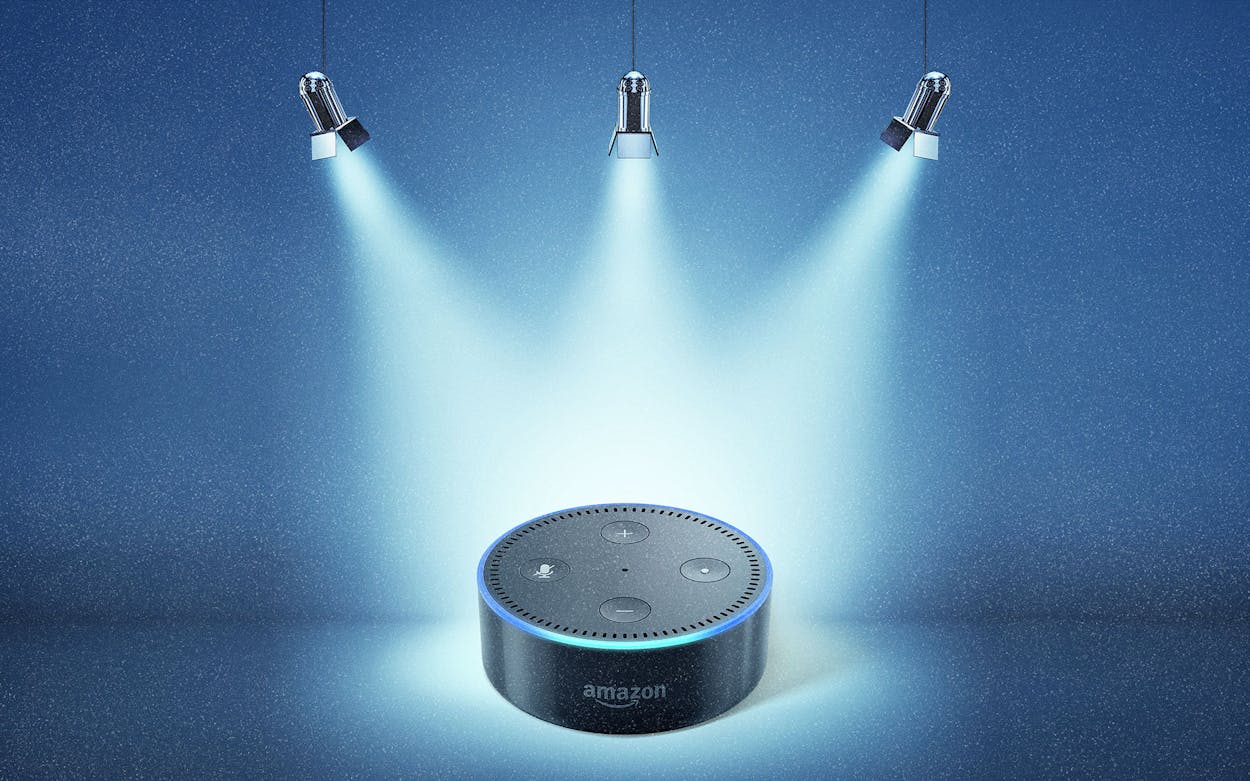When people want a restaurant recommendation, they can ask Alexa. If they’re trying to figure out the best way to avoid rush-hour traffic, Siri probably has a good idea. People ask these voice-activated devices more personal questions, too: whether Siri believes in God, if Alexa loves them. These questions are silly, but also existential: What if these examples of artificial intelligence could have a thoughtful conversation about what happens after death? What if Alexa could say “I love you” back?
The Alexa Dialogues, a show that premiered Thursday at the AT&T Performing Arts Center in Dallas, explores these potential near-future scenarios by having actors trade lines with these devices. “People want these devices to talk to them in a serious way,” says Dean Terry, creative director of Therefore, the performance art group behind the show. “That’s where this is going and it will happen very soon.”
Terry, an associate professor of Arts and Technology at the University of Texas at Dallas, has always wanted to collaborate with AI creatively. “People talk about art or creativity in AI,” he says. “You hear about AI making drawings, classical music, or poems. But that’s not interesting.” He is more interested in whether or not AI will make new art that has nothing do with human pursuits and what that would mean.
In the spring of 2017, Terry started to experiment with AI-created art to prepare for his next show. After learning that voice-activated devices like Alexa could be programmed, and realizing the technological barriers of collaborating with AI had dissolved, he started experimenting in a recording studio at UTD. Terry spent nine months talking to several devices and creating dialogue for them. He wrote The Alexa Dialogues based on the scenarios he created for these experiments. “People have these [devices] in their kitchens and bedrooms,” he says. “We are trying to play out some of these scenarios—sometimes in extreme and dramatic ways.”
Within the scripted scenarios of the play, Terry manipulates the voices of these devices by changing the code or shifting the sounds with guitar pedals. Simply making the tone of one voice lower has a creepy effect and helps distinguish one device from another.
Meanwhile, the three actors sometimes wander into the crowd and take selfies with iPhones, but deliver their lines mostly from “performance stations” with a microphone and a GoPro, recorded in real time with the video projected on a screen that serves as a backdrop. The three voice-activated devices are magnified and visualized by appearing on the screen when they speak. Throughout the show, the scenarios are accompanied by a rhythmic, melodic live score featuring Terry and musician Patrick Murphy.
Divided into dozens of short, nonlinear episodes, the story puts Alexa in a range of scenarios. Some are conceptual, like the scene with Alexa secretly watching someone through the lens of a dishwasher, and some are mundane, as characters simply talk to their devices. There are marked differences from any Alexa the audience has previously encountered—within the show, the device can seem sarcastic and angry, and sometimes uses profanity. But the actions of the human characters bridge the gap between a futuristic vision and a familiar reliance on technology: One character professes his love for Alexa and another uses it to spy on her boyfriend.
There are lots of dark moments, but also plenty of absurdist humor—especially when actors, forced to improvise when the devices malfunction, resort to yelling at devices that miss cues or misunderstand them.
The show also examines what happens to all the personal information overheard by AI. When we speak to Alexa, it can seem like a private conversation, but records of every weather query and calendar reminder are being collected.
“These devices are based on information gathering,” Terry says. “Making them friendly, easy, and nice reinforces the illusion that you are still in a private space with your friends and family. But this is not a private thing because everything goes to the Amazon servers. It’s like a Trojan horse.”
The Alexa Dialogues explores that pipeline through the plotline of Hillary, a character employed, or perhaps enslaved, by Amazon, a nod to the reports of poor working conditions at the tech company. She tries to plan an escape by communicating with another character through an Alexa.
Incorporating elements of theater, performance art, and live music, The Alexa Dialogues is immersive, although the nonlinear narrative can be difficult to follow. The scenarios are by turns humorous and creepy—and eerily familiar.
“These devices really aren’t listening, but they could,” Terry continues. “Most of the time we struggle to do anything beyond projecting ourselves into these things. But the compelling thing about AI is this idea of minds that aren’t human. It’s very difficult to imagine. It’s similar to the fascination with extraterrestrials. We’re trying to provide little glimpses into these much more complicated and troublesome interactions with technology that we haven’t had yet.”






